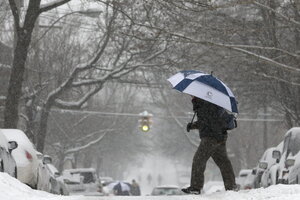Storm delivers another bout of snow and icy roads to winter-weary Northeast
The Northeast wrestled Wednesday with another winter storm that closed schools and snarled travel. But by day's end the storm, which previously heaped snow in the nation's mid-section, was moving out.

A pedestrian walks in the snow in Albany, N.Y, on Wednesday. Hundreds of schools across upstate New York are closed and authorities are advising against any unnecessary travel as a snowstorm moves across the region, scuttling travel plans and upending routines across the Northeast.
Mike Groll/AP
The Northeast wrestled with yet another bout of snow on Wednesday, the latest in a series of snowstorms that have tumbled into the region this winter season, closing schools and muddling travel plans.
A winter storm that whirled through the country's mid-section on Tuesday – delivering especially big snowfalls across Kansas – slid into the Northeast Wednesday morning, bearing buckets of snow and freezing rain. The storm’s rain and sleet made for dangerous roads across the East Coast, even as the snowfall began to let up across the region around lunch-hour.
“Most of the storm is now in the rearview mirror,” says Brian Hurley, a meteorologist with the Weather Prediction Center at the National Weather Service, around 2 p.m. He added that some light snow accumulation is still predicted for eastern New York and parts of New England, in addition to the rain still expected for much of the Northeast, as the snowfall begins to ease.
In Massachusetts, where between six and ten inches of snow were expected in Boston, and up to 14 inches of snow were predicted for the state’s highest elevations, a winter-storm warning was in effect for most of the state until 6 p.m. Wednesday. The National Weather Service said that though the snow would let up around noon across the state, drizzle would continue throughout the day, keeping roads hazardous until evening.
Rhode Island, southern New Hampshire, and northern Connecticut were under the same winter storm warning, with each expected to get around half a foot of snow, as well an icing of freezing rain, according to The National Weather Service. In Connecticut, where up to 10 inches of snow were predicted for some parts of the state, Gov. Dan P. Malloy delayed the start of the General Assembly’s annual session, at which he will give his State of the State address, until Thursday at noon.
In New York, Gov. Andrew Cuomo declared a state of emergency Wednesday morning. In a conference call with reporters, he cautioned New Yorkers not to brave the state’s ice-lacquered, slick roads and said he had ordered closed NY’s Interstate 84 from the Pennsylvania to the Connecticut border.
In addition, Mr. Cuomo warned of a “dire” salt shortage in the state, after already having had to shell out thousands of tons of the stuff onto dangerous roads this winter, new outlets reported.
Last winter, New York City’s Department of Sanitation used 346,112 tons of road salt to clear icy roads, according to The New York Times. The department began this winter with roughly 250,000 tons and has already had to reach out to the state for a resupply this season, the Times said.
In New York City, public schools remained open, but three inches of snow, and a batch of freezing rain to boot, grated at New Yorkers’ morning commute.
Across the Northeast, thousands of residents had also lost power. In New Jersey, which is under a state of emergency, about 60,000 people did not have lights or heat, and about 2,500 New York City residents and 5,000 Long Islanders were without electricity, The New York Times reported. In central Pennsylvania, almost 500,000 people were without power, a PECO Energy spokesperson told The Wall Street Journal.
Vermont is expected to get between five and 10 inches of snow, and Ohio could get up to eight inches of the white stuff, according to the National Weather Service.
A total of 2,654 flights in the US had been cancelled as of about 1 p.m. on Wednesday, and another 2,325 US flights had been delayed, according to Flightaware.com. More than half of the flights out of Boston’s Logan Airport and NJ’s Newark Airport were canceled, and almost half were canceled out of New York’s LaGuardia and JFK airports.
A day earlier, the same storm had put Kansas in what Gov. Sam Brownback called a state of "disaster emergency," Reuters reported. The storm dropped an average of about 8 to 12 inches there, with the highest snowfall of the entire storm – 15.5 inches – in Eskridge, Kansas, according to the National Weather Service.
The storm also dumped snow on Missouri, Iowa, Illinois, Indiana, and Michigan Tuesday evening and overnight, and the Plains have since been left in unusually cold temperatures, as much as 40 degrees below average in some places, according to the National Weather Service.
Meanwhile, California and Oregon are expected to get some much-needed rain and snow beginning late on Thursday, says Mr. Hurley. The National Weather Service is also monitoring a potential snowstorm that could roll into New England over the weekend, he says.

